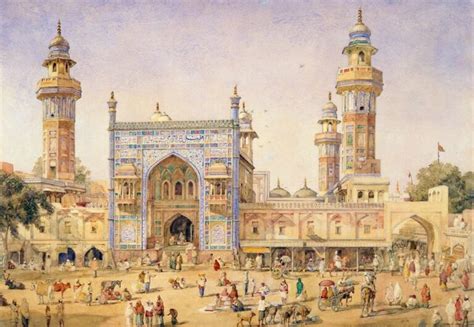The Mughal Empire, established in 1526, emerged as one of the most powerful and influential empires in Indian history. Known for its vast territorial expanse, cultural achievements, and economic prosperity, the empire played a pivotal role in shaping the subcontinent’s landscape. Among its enduring legacies is the empire’s support for religious tolerance and artistic patronage.

Unlike many previous and subsequent rulers in India, the Mughal emperors exhibited a remarkable openness to different religions. This policy of religious tolerance stemmed from their belief in the pluralistic nature of society and the importance of respecting the beliefs of all citizens.
Akbar’s Policies: Emperor Akbar, who reigned from 1556 to 1605, was a staunch advocate of religious tolerance. He repealed the discriminatory taxes imposed on non-Muslims by previous rulers and established a policy of equal treatment for all citizens regardless of their faith. He also convened a council of religious scholars from different faiths to promote interfaith dialogue and understanding.
Jahangir’s Continuation: Jahangir, Akbar’s son who succeeded him to the throne, continued his father’s legacy of religious tolerance. He appointed non-Muslims to high positions in his administration and maintained a policy of respect for all religions.
Aurangzeb’s Complex Legacy: Aurangzeb, who ruled from 1658 to 1707, is often portrayed as a less tolerant emperor than his predecessors. While he did introduce some restrictions on non-Muslims, such as the re-imposition of the jizya tax, he also protected Sikh and Christian communities.
The Mughal emperors were distinguished by their avid patronage of art and architecture, which flourished under their rule. Their courts became centers of artistic innovation, attracting master artisans and craftsmen from across the empire.
Architecture: The Mughals were renowned for their architectural marvels, which showcased the fusion of Indian, Persian, and Islamic influences. The Taj Mahal, commissioned by Shah Jahan as a mausoleum for his wife, is widely regarded as one of the most beautiful buildings in the world. Other notable architectural achievements include the Red Fort in Delhi, the Jama Masjid mosque, and the Agra Fort.
Painting: The Mughal period witnessed a golden age of miniature painting. The Mughal emperors commissioned numerous paintings depicting court scenes, hunting expeditions, and historical events. These paintings were characterized by their intricate details, vibrant colors, and realistic depictions.
Textiles: The Mughal Empire was also known for its exquisite textiles. The emperor’s workshops produced luxurious fabrics such as silk, brocade, and velvet, which were adorned with intricate designs and motifs. These textiles were highly prized both within the empire and beyond.
The Mughal Empire’s policies of religious tolerance and artistic patronage had a profound impact on Indian culture. The empire’s legacy can be seen in the following aspects:
Pluralistic Society: The Mughal Empire’s emphasis on religious tolerance contributed to the development of a pluralistic society in India. People of different faiths lived side by side in relative harmony, fostering a spirit of mutual respect and understanding.
Artistic Heritage: The Mughals left behind a vast artistic legacy that continues to inspire and amaze. Their architectural masterpieces are among the most iconic landmarks in India. Their paintings and textiles are also treasured works of art that showcase the ingenuity and skill of their creators.
Cultural Exchange: The Mughal Empire facilitated cultural exchange between India and other parts of the world. Through their patronage of art and trade, the Mughals introduced new ideas, techniques, and artistic influences into India. Conversely, Indian culture also influenced the arts and sciences of the Middle East and Central Asia.
The Mughal Empire’s support for religious tolerance and artistic patronage was a defining feature of its reign. This policy of tolerance created a climate of respect and understanding among different religious communities. At the same time, the empire’s patronage of the arts led to the creation of some of the most exquisite works of art in human history. The Mughal Empire’s legacy continues to shape Indian culture to this day, fostering a spirit of pluralism and appreciation for artistic excellence.
Table 1: Mughal Emperors and Their Policies on Religious Tolerance
| Emperor | Reign | Policies |
|---|---|---|
| Akbar | 1556-1605 | Repealed discriminatory taxes on non-Muslims, convened a council of religious scholars |
| Jahangir | 1605-1627 | Appointed non-Muslims to high positions, maintained a policy of respect for all religions |
| Aurangzeb | 1658-1707 | Re-imposed jizya tax on non-Muslims, but also protected Sikh and Christian communities |
Table 2: Major Architectural Achievements of the Mughal Empire
| Structure | Location | Period of Construction |
|---|---|---|
| Taj Mahal | Agra | 1632-1653 |
| Red Fort | Delhi | 1546-1605 |
| Jama Masjid | Delhi | 1650-1656 |
| Agra Fort | Agra | 1565-1573 |
Table 3: Famous Mughal Paintings
| Title | Artist | Period of Creation |
|---|---|---|
| Shah Jahan Receiving a Ruler | Mansur | 1620s |
| Akbar and his Court | Basawan | 1580s |
| A Hunting Cheetah | Manohar | 1660s |
Table 4: Mughal Textiles and Their Motifs
| Fabric | Motifs | Period |
|---|---|---|
| Silk | Floral, geometric, animal | 16th-18th centuries |
| Brocade | Intricate gold and silver threads | 17th-18th centuries |
| Velvet | Plain, embossed, or embroidered | 16th-18th centuries |
